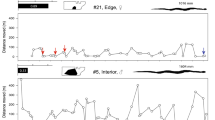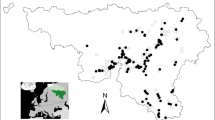Abstract
This work assesses whether the width and “permanence” of linear clearings affects the distribution and movement patterns of small, terrestrial vertebrates in a native South Australian woodland. We examined the influence of narrow (1.5 and 4.2 m), non-permanent seismic exploration tracks; and wide (6–7 and 12–15 m), permanent fire tracks. There were 1,007 captures of 14 species (four amphibians, six reptiles, four mammals) from 18,000 trap days/nights across 15 sites. Total species richness was highest adjacent to 6–7 m wide permanent tracks (8.3) and lowest in areas without clearings (5.3). There was heterogeneity of captures between track types (p < 0.008), species (p < 0.001), and species by track type (p < 0.001). Antechinus flavipes was most abundant adjacent to both types of permanent tracks, probably as a result of increased habitat complexity at these sites. Twenty-four percent of movements by recaptured A. flavipes involved track crossings. Animals crossed all track types; nevertheless, individuals were more likely to be recaptured on the same side of a track. Individuals were less likely to cross permanent tracks (p = 0.025 for 6–7 m and p = 0.008 for 12 to 15-m-wide tracks), with females being particularly inhibited. Although 11 % of 56 recaptured Rattus spp. had crossed a track, no individuals crossed the 12 to 15-m permanent tracks. In the habitat type studied here, narrow seismic lines may have a slightly positive effect on some ground-dwelling vertebrates, and do not appear to substantially inhibit movement. However, there is a need to carefully manage permanent tracks, which could isolate faunal populations.


Similar content being viewed by others
References
Allison LM, Gibson LA, Aberton JG (2006) Dietary strategy of the swamp antechinus (Antechinus minimus maritimus) (Marsupialia: Dasyuridae) in coastal and inland heathland habitats. Wildl Res 33:67–76
Anderson CS, Cady AB, Meikle DM (2003) Effects of vegetation structure and edge habitat on the density and distribution of white-footed mice (Peromyscus leucopus) in small and large forest patches. Can J Zool 81:897–904
Baker S, Lauck B (2006) Association of common brown froglets, Crinia signifera, with clearcut forest edges in Tasmania. Wildl Res 33:29–34
Banks SC, Finlayson GR, Lawson SJ, Lindenmayer DB, Paetkau D, Ward SJ, Taylor AC (2005a) The effects of habitat fragmentation due to forestry plantation establishment on the demography and genetic variation of a marsupial carnivore, Antechinus agilis. Biol Conserv 122:581–597
Banks SC, Lindenmayer DB, Ward SJ, Taylor AC (2005b) The effects of habitat fragmentation via forestry plantation establishment on spatial genotypic structure in the small marsupial carnivore, Antechinus agilis. Mol Ecol 14:1667–1680
Banks SC, Ward SJ, Lindenmayer DB, Finlayson GR, Lawson SJ, Taylor AC (2005c) The effects of habitat fragmentation on the social kin structure and mating system of the agile antechinus, Antechinus agilis. Mol Ecol 14:1789–1800
Bos DG, Carthew SM (2007) Patterns of movement in the small dasyurid, Ningaui yvonneae. Aust J Zool 55:299–307
Branch LC, Clark AM, Moler PE, Bowen BW (2003) Fragmented landscapes, habitat specificity and conservation genetics of three lizards in Florida scrub. Conserv Gen 4:199–212
Burnett SE (1992) Effects of a rainforest road on movements of small mammals: mechanisms and implications. Wildl Res 19:95–104
Carthew SM, Horner B, Jones KMW (2009) Do utility corridors affect movements of small terrestrial fauna? Wildl Res 36:488–495
Cheal DC (1987) The diets and dietary preferences of Rattus fuscipes and Rattus lutreolus at Walkerville in Victoria. Aust Wildl Res 14:35–44
Claridge AW, Paull D, Dawson J, Mifsud G, Murray AJ, Poore R, Saxon MJ (2005) Home range of the spotted-tailed quoll (Dasyurus maculatus) a marsupial carnivore, in a rainshadow woodland. Wildl Res 32:7–14
Cockburn A, Scott MP, Scotts DJ (1985) Inbreeding avoidance and male-biased natal dispersal in Antechinus spp. (Marsupialia: Dasyuridae). Anim Behav 33:908–915
Eigenbrod F, Hecnar SJ, Fahrig L (2008) Accessible habitat: an improved measure of the effects of habitat loss and roads on wildlife populations. Landsc Ecol 23:159–168
Fagan WF, Cantrell RS, Cosner C (1999) How habitat edges change species. Am Nat 153:165–182
Fahrig L (2003) Effects of habitat fragmentation on biodiversity. Ann Rev Ecol Syst 34:487–515
Forman RTT, Alexander LE (1998) Roads and their major ecological effects. Ann Rev Ecol Syst 29:207–231
Fox BJ, Fox MD (2000) Factors determining mammal species richness on habitat islands and isolates: habitat diversity, disturbance, species interactions and guild assembly rules. Glob Ecol Biogeogr 9:19–37
Friend GR (1985) Ecological studies of a population of Antechinus bellus (Marsupialia: Dasyuridae) in Tropical Northern Australia. Aust Wildl Res 12:151–162
Fuentes-Montemayor E, Cuaron AD, Vazquez-Dominguez E, Benitez-Malvido J, Valenzuela-Galvan D, Andresen E (2009) Living on the edge: roads and edge effects on small mammal populations. J Anim Ecol 78:857–865
Garden JG, McAlpine CA, Possingham HP, Jones DN (2007) Habitat structure is more important than vegetation composition for local-level management of native terrestrial reptile and small mammal species living in urban remnants: a case study from Brisbane, Australia. Austral Ecol 32:669–685
Gascon C, Lovejoy TE, Bierregaard RO Jr, Malcolm JR, Stouffer PC, Vasconcelos HL, Laurance WF, Zimmerman B, Tocher M, Borges S (1999) Matrix habitat and species richness in tropical forest remnants. Biol Conserv 91:223–229
Gepp BC, Grigg BR, Boardman R, Kettle L, Kloeden DK (1998) Nangwarry native forest reserve management plan. Forestry SA, Adelaide
Goldingay RL, Whelan RJ (1997) Powerline easements: do they promote edge effects in eucalypt forest for small mammals? Wildl Res 24:737–744
Goosem M (1997) Internal fragmentation: the effects of roads, highways and powerline clearings on movements and mortality of rainforest vertebrates. In: Laurance WF, Bierregaard RO Jr (eds) Tropical forest remnants. Ecology management and conservation of fragmented communities. University of Chicago Press, Chicago, pp 241–255
Goosem M (2000) Effects of tropical rainforest roads on small mammals: edge changes in community composition. Wildl Res 27:151–163
Goosem M (2001) Effects of tropical rainforest roads on small mammals: inhibition of crossing movements. Wildl Res 28:351–364
Goosem M, Marsh H (1997) Fragmentation of a small-mammal community by a powerline corridor through tropical rainforest. Wildl Res 24:613–629
Goszczynski J, Posluszny M, Pilot M, Gralak B (2007) Patterns of winter locomotion and foraging in two sympatric marten species: Martes martes and Martes foina. Can J Zool 85:239–249
Hall S (1980) The diets of two coexisting species of Antechinus (Marsupialia: Dasyuridae). Aust Wildl Res 7:365–378
Jaques L, Huleatt M (2009) Australian mineral exploration peaks. AusGeo News 93:1–5
Laurance WF (1994) Rainforest fragmentation and the structure of small mammal communities in tropical Queensland. Biol Conserv 69:23–32
Lazenby-Cohen KA, Cockburn A (1991) Social and foraging components of the home range in Antechinus stuartii (Dasyuridae: Marsupialia). Aust J Ecol 16:301–307
Lee P, Boutin S (2006) Persistence and developmental transition of wide seismic lines in the western Boreal Plains of Canada. J Environ Manag 78:240–250
Lehvavirta S, Kotze DJ, Niemela J, Mantysaari M, O’Hara B (2006) Effects of fragmentation and trampling on carabid beetle assemblages in urban woodlands in Helsinki, Finland. Urban Ecosyst 9:13–26
Leung LKP (1999) Ecology of Australian tropical rainforest mammals. I. The Cape York Antechinus, Antechinus leo (Dasyuridae:Marsupialia). Wildl Res 26:287–306
Lidicker WZ (1999) Responses of mammals to habitat edges: an overview. Landsc Ecol 14:333–343
Marchesan D, Carthew SM (2004) Autecology of the yellow-footed antechinus (Antechinus flavipes) in a fragmented landscape in southern Australia. Wildl Res 31:273–282
Marchesan D, Carthew SM (2008) Use of space by the yellow-footed antechinus, Antechinus flavipes, in a fragmented landscape in South Australia. Landsc Ecol 23:741–752
Marsh DM, Milam GS, Gorham NP, Beckman NG (2004) Forest roads as partial barriers to terrestrial salamander movement. Conserv Biol 19:2004–2008
McGregor RL, Bender DJ, Fahrig L (2008) Do small mammals avoid roads because of traffic? J Appl Ecol 45:117–123
Monamy V, Fox BJ (2000) Small mammal succession is determined by vegetation density rather than time elapsed since disturbance. Aust Ecol 25:580–587
Peakall R, Ebert D, Cunningham R, Lindenmayer D (2006) Mark-recapture by genetic tagging reveals restricted movements by bush rats (Rattus fuscipes) in a fragmented landscape. J Zool 268:207–216
Pearce JL, Venier LA, Eccles G, Pedlar J, McKenney D (2005) Habitat islands, forest edge and spring-active invertebrate assemblages. Biol Conserv 14:2949–2969
Riley SPD, Pollinger JP, Sauvajot RM, York EC, Bromley C, Fuller TK, Wayne RK (2006) A southern California freeway is a physical and social barrier to gene flow in carnivores. Mol Ecol 15:1733–1741
Rondinini C, Doncaster CP (2002) Roads as barriers to movement for hedgehogs. Funct Ecol 16:504–509
Salek M, Svobodova J, Zasadil P (2010) Edge effect of low-traffic forest roads on bird communities in secondary production forests in central Europe. Landsc Ecol 25:1113–1124
Schall R (1991) Estimation in generalized linear models with random effects. Biometrika 78:719–727
Schtickzelle N, Baguette M (2003) Behavioural responses to habitat patch boundaries restrict dispersal and generate emigration-patch area relationships in fragmented landscapes. J Anim Ecol 72:533–545
Shepard DB, Kuhns AR, Dreslik ML, Phillips CA (2008) Roads as barriers to animal movement in fragmented landscapes. Anim Conserv 11:288–296
Smith GC (1984) The biology of the yellow-footed antechinus, Antechinus flavipes (Marsupialia: Dasyuridae), in a swamp forest on Minaba Island, Cooloola, Queensland. Aust Wildl Res 11:465–480
Spencer RJ, Cavanough VC, Baxter GS, Kennedy MS (2005) Adult free zones in small mammal populations: response of Australian native rodents to reduced cover. Aust Ecol 30:868–876
Strasburg JL (2006) Roads and genetic connectivity. Nature 440:875–876
Swihart RK, Slade NA (1984) Road crossing in Sigmodon hispidus and Microtus ochrogaster. J Mammal 65:357–360
Trombulak SC, Frissell CA (2000) Review of ecological effects of roads on terrestrial and aquatic communities. Conserv Biol 14:18–30
VSN International (2012) GenStat for Windows, 15th edn. VSN International, Hemel Hempstead
Wilson BA, Bourne AR, Jessop RE (1986) Ecology of small mammals in coastal heathland at Anglesea, Victoria. Aust Wildl Res 13:397–406
Acknowledgments
Barrie Grigg and his team from Forestry SA in Nangwarry and Mt Gambier are thanked for re-slashing the seismic exploration lines and for helping with pitfall trap installation. Gerhard Kubach did most of the fieldwork for this project, while Zenggi Zhao, Tim Murphy and Annette Reineke provided valuable field assistance. Laura Ruykys provided valuable comments on the manuscript. The work was kindly funded by PIRSA and Boral Energy Resources. This research complied with ethical standards in the treatment of animals and was conducted under University of Adelaide Animal Ethics approval no. W/32/99A and South Australian National Parks and Wildlife permit no. U23866.
Author information
Authors and Affiliations
Corresponding author
About this article
Cite this article
Carthew, S.M., Jones, K.M.W. & Lawes, M. Responses of small vertebrates to linear clearings in a South Australian woodland. Ecol Res 28, 1003–1010 (2013). https://doi.org/10.1007/s11284-013-1082-5
Received:
Accepted:
Published:
Issue Date:
DOI: https://doi.org/10.1007/s11284-013-1082-5




